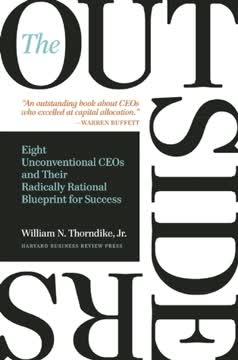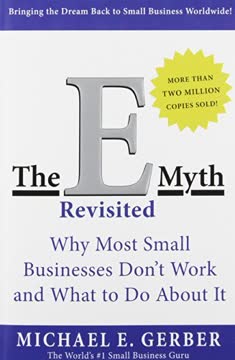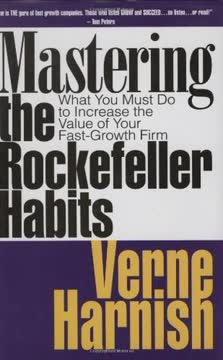Key Takeaways
1. Prioritize Execution: Focus on Doing the Right Things Right
"You don't manage people. You lead people and manage their activities."
Strategic Framework for Business. The Right Things Right model provides a comprehensive approach to business management by balancing people and processes. This framework helps leaders make critical decisions about their organization's strategic direction and operational execution.
Key Components of Business Success:
- Right People: Hiring and developing top talent
- Right Things: Defining strategic direction and customer needs
- Doing Things Right: Creating efficient processes and systems
Balancing Stakeholder Needs. The model emphasizes the importance of simultaneously satisfying customers, employees, and shareholders while maintaining operational efficiency. Leaders must continuously balance the needs of different stakeholders and improve both reputation and productivity.
2. Create a One-Page Strategic Plan for Clarity and Alignment
"You must remember that this process is 1 percent vision and 99 percent alignment."
Strategic Simplification. The One-Page Strategic Plan (OPSP) transforms complex strategic thinking into a single, actionable document. By condensing the company's vision, goals, and priorities into one page, organizations can create crystal-clear communication and focus.
Strategic Planning Elements:
- Long-term vision (10-25 years)
- Quarterly and annual priorities
- Core values and purpose
- Measurable goals and metrics
- Accountability assignments
Cascading Alignment. The OPSP enables organizations to create a consistent narrative from top-level strategic goals to individual employee objectives, ensuring everyone understands their role in achieving company success.
3. Develop Core Values to Build a Strong Organizational Culture
"Have a few rules, repeat yourself a lot, and act consistently with those rules."
Cultural Foundation. Core values serve as the fundamental guidelines that shape an organization's identity, decision-making, and behavior. They provide a consistent framework for hiring, performance management, and strategic direction.
Core Values Implementation Strategies:
- Use storytelling to reinforce values
- Integrate values into recruitment and onboarding
- Align performance evaluations with core values
- Celebrate employees who exemplify organizational principles
Cultural Consistency. By consistently communicating and living core values, organizations create a strong, cohesive culture that attracts and retains top talent while guiding strategic decisions.
4. Master Meeting Rhythms to Drive Performance
"Routine sets you free. If you don't have a meeting rhythm, you don't have a business."
Strategic Meeting Architecture. Implementing a structured meeting rhythm with daily, weekly, monthly, and quarterly meetings creates organizational alignment, accountability, and continuous improvement.
Meeting Rhythm Components:
- Daily 5-15 minute huddles
- Weekly team meetings
- Monthly learning and alignment sessions
- Quarterly strategic reviews
- Annual planning sessions
Performance Acceleration. Consistent, well-structured meetings help organizations quickly identify and resolve issues, maintain focus on key priorities, and harness collective intelligence.
5. Identify and Control Your Market's Chokepoint
"Control the bottleneck or chokepoint in your industry to gain a competitive advantage."
Strategic Differentiation. Understanding and controlling the critical constraint in your industry allows companies to create unique value propositions and sustainable competitive advantages.
Chokepoint Identification Strategies:
- Analyze industry supply chains
- Identify critical resource limitations
- Explore technological barriers
- Recognize distribution challenges
Competitive Positioning. By strategically addressing the most significant limitation in their market, companies can create unique value and establish market leadership.
6. Collect Continuous Customer and Employee Feedback
"Recurring problems eat up more than 40 percent of the average employee's time."
Systematic Improvement Process. Implementing a structured feedback system helps organizations continuously identify and resolve operational inefficiencies and customer pain points.
Feedback Collection Methods:
- Weekly problem logging
- Customer and employee surveys
- Regular review of recurring issues
- Cross-functional problem-solving teams
Organizational Learning. By creating a culture of continuous feedback and improvement, companies can enhance productivity, customer satisfaction, and employee engagement.
7. Understand and Improve Cash Flow Constantly
"Cash is the oxygen that fuels growth."
Financial Performance Management. Continuously monitoring and improving the cash conversion cycle enables organizations to fund growth through internally generated cash and reduce dependence on external financing.
Cash Flow Optimization Strategies:
- Track cash conversion cycle
- Identify bottlenecks in financial processes
- Implement quarterly cash improvement initiatives
- Reduce time between spending and receiving money
Financial Resilience. By developing a deep understanding of cash flow dynamics, companies can create more sustainable and adaptable business models.
Last updated:
FAQ
What's "Mastering the Rockefeller Habits" about?
- Focus on Growth: "Mastering the Rockefeller Habits" by Verne Harnish is a guide for business leaders on how to scale their companies effectively.
- Rockefeller Habits: The book introduces the Rockefeller Habits, a set of principles inspired by John D. Rockefeller's management practices.
- Practical Tools: It provides practical tools and strategies for managing growth, improving communication, and aligning teams.
- Target Audience: The book is aimed at CEOs and executives of mid-sized firms looking to grow their businesses sustainably.
Why should I read "Mastering the Rockefeller Habits"?
- Proven Strategies: The book offers proven strategies that have helped numerous companies achieve significant growth.
- Real-World Examples: It includes testimonials and case studies from successful business leaders who have implemented these habits.
- Actionable Advice: The book is filled with actionable advice that can be immediately applied to improve business operations.
- Comprehensive Framework: It provides a comprehensive framework for addressing common challenges faced by growing companies.
What are the key takeaways of "Mastering the Rockefeller Habits"?
- Priorities, Data, Rhythm: Focus on setting clear priorities, gathering relevant data, and establishing a rhythm of regular meetings.
- One-Page Strategic Plan: Use a concise strategic plan to align the organization and communicate goals effectively.
- Core Values: Define and live by core values to strengthen company culture and guide decision-making.
- Cash Flow Management: Improve cash flow through strategies like shortening cycle times and eliminating mistakes.
How does the One-Page Strategic Plan work in "Mastering the Rockefeller Habits"?
- Simplified Planning: The One-Page Strategic Plan condenses a company's vision, goals, and strategies into a single, easily digestible page.
- Alignment Tool: It serves as a tool for aligning the entire organization around key objectives and priorities.
- Regular Updates: The plan is meant to be updated regularly to reflect changes in the business environment and strategic direction.
- Focus on Execution: It emphasizes execution by breaking down long-term goals into actionable quarterly and annual priorities.
What is the significance of the Rockefeller Habits in the book?
- Historical Inspiration: The habits are inspired by John D. Rockefeller's management practices, known for their effectiveness in scaling businesses.
- Three Core Habits: The book focuses on three core habits: setting priorities, gathering data, and establishing a meeting rhythm.
- Foundation for Growth: These habits provide a foundation for sustainable growth by improving communication and accountability.
- Widely Adopted: Many successful companies have adopted these habits to drive performance and achieve their growth objectives.
How does "Mastering the Rockefeller Habits" address cash flow management?
- Cash Conversion Cycle: The book emphasizes the importance of understanding and improving the cash conversion cycle (CCC).
- Practical Strategies: It offers practical strategies for accelerating cash flow, such as billing more frequently and improving collections.
- Business Model Adjustments: Encourages businesses to adjust their models to improve cash flow, like getting customers to pay in advance.
- Daily Cash Reports: Recommends daily cash reports to keep cash flow top-of-mind and allow for quick adjustments.
What role do core values play in "Mastering the Rockefeller Habits"?
- Cultural Foundation: Core values serve as the cultural foundation of a company, guiding behavior and decision-making.
- Recruitment and Retention: They are used in recruitment and retention to ensure alignment between employees and the company.
- Daily Reinforcement: The book suggests ways to reinforce core values daily, such as storytelling and recognition programs.
- Alignment and Consistency: Core values help maintain alignment and consistency across the organization, especially during growth.
How does "Mastering the Rockefeller Habits" suggest handling meetings?
- Structured Meetings: The book advocates for structured daily, weekly, monthly, and quarterly meetings to maintain alignment and focus.
- Short and Focused: Meetings should be short and focused, with specific agendas to maximize efficiency and effectiveness.
- Daily Huddles: Daily huddles are recommended to quickly address issues and keep everyone informed and aligned.
- Peer Pressure and Accountability: Regular meetings create peer pressure and accountability, driving performance and execution.
What are some of the best quotes from "Mastering the Rockefeller Habits" and what do they mean?
- "Routine sets you free." This quote emphasizes the importance of establishing regular routines and rhythms to create freedom and efficiency in business operations.
- "If you want to teach people a new way of thinking, don’t bother trying to teach them. Instead, give them a tool." This highlights the book's focus on providing practical tools that lead to new ways of thinking and operating.
- "The key is not what core values an organization has but that it has core values at all." This underscores the importance of having core values to guide the organization, regardless of what they specifically are.
- "You don’t have a real strategy if it doesn’t pass these two tests: that what you’re planning to do really matters to your existing and potential customers; and second, it differentiates you from your competition." This quote stresses the need for a strategy that is both customer-focused and differentiating.
How does "Mastering the Rockefeller Habits" help with setting priorities?
- Top 5 and Top 1 of 5: The book introduces the concept of setting a Top 5 and a Top 1 of 5 priorities to maintain focus.
- Alignment Across Organization: It emphasizes the need for alignment across the organization, with each team and individual setting their own aligned priorities.
- Management Accountability Plan: Provides a framework for assigning accountability and tracking progress on priorities.
- Focus on Execution: Encourages focusing on execution by breaking down priorities into actionable steps and regularly reviewing progress.
How does "Mastering the Rockefeller Habits" suggest improving customer and employee feedback?
- De-Hassling System: The book recommends creating a system to gather and address recurring customer and employee hassles.
- Start/Stop/Keep Questions: Suggests using start/stop/keep questions to gather feedback and identify areas for improvement.
- Regular Feedback Loops: Emphasizes the importance of regular feedback loops to continuously improve products, services, and processes.
- Leadership Development: Encourages using feedback systems as a leadership development opportunity for mid-level managers.
What is the role of the Brand Promise in "Mastering the Rockefeller Habits"?
- Differentiation: The Brand Promise is a key differentiator that sets a company apart from its competitors.
- Customer Focus: It focuses on what really matters to customers and aligns with their needs and expectations.
- Measurable Deliverable: The Brand Promise should be a measurable deliverable that drives all strategic and tactical decisions.
- Evolving Over Time: The book acknowledges that a Brand Promise may need to evolve over time as market conditions and customer needs change.
Review Summary
Mastering the Rockefeller Habits receives mostly positive reviews, with readers praising its practical advice for growing businesses. Many find the book's focus on priorities, data, and meeting rhythms helpful. Some note it's more suitable for established companies rather than startups. Readers appreciate the emphasis on setting clear goals and differentiating from competitors. Critics mention the book's dated references and occasionally dense content. Overall, it's seen as a valuable resource for business leaders seeking structured growth strategies.
Similar Books









Download PDF
Download EPUB
.epub digital book format is ideal for reading ebooks on phones, tablets, and e-readers.






